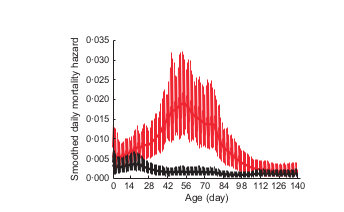Sheep update
Discussion goals
- Sheep study progress
- Objectives under current funding
- How to package / approach existing data
What we've done
(2013-Present)
1. Basic description
Cassirer et al. 2013 JAE



2. Acquired immunity
Plowright et al., 2013 PLoS One



3. Social compartmentalization
Manlove et al., 2014 PRSB


4. Persistence / phase transition
Manlove et al., almost in review




5. Who carries in the wild?
Plowright et al., in prep
6. New strain produces all-age die-off in infected herd
Cassirer et al., in prep



Current MAF Objectives
Objective 1
-ID groups with poor outcomes (Manlove et al., PRSB)
-Inference on carriage rates through time
-ID individual M.ovi carriers (Raina @ Lostine; Frances @ Asotin, Black Butte, Mtn View
- Ewe-group structure / contact patterns (Manlove field data)
-> "vert" vs. "horizontal" transmission
-> force of infection from different demographic groups
- Risk factor analysis
Objective 2: Mechanistic models of carrier etiology
Objective 3: Modeling control strategies
(Plowright et al., 2012 - May 2016)
Sheep society in the wild
Overview
Goal
Quantify social dynamics of bighorn nursery groups with disease
- Associations (who's in a group together)
- Interactions (who touches who)
- Disease progression (symptoms + mortalities)
Methods
- Marked/sampled as many animals as possible overwinter (Frances)
-
Followed up from ~April 20 - July 15
- Locate everybody every day
- Determine lamb status
- Focal follows & scan samples
- Symptoms & carcass recovery
Data collected
| Pop | Year | # Marked (total) | # relocations | # follows / ID'd animals followed | Disease Status |
|---|---|---|---|---|---|
| Asotin | 2013 | 12 / 32 | 554 | infected no transmission | |
| 2014 | 17 / 25 | 1135 | 191 / 883 | infected no transmission | |
| 2015 | 23 / 28 | 1444 | 239 / 1095 | infected no transmission | |
| Black Butte | 2013 | 4 / 13 | 124 | Outbreak | |
| 2014 | 11 / 13 (all recognizable) | 718 | 155 / 581 | New strain | |
| Mtn View | 2015 |
13 / 30 | 516 | 191 / 548 | infected / no transmission |
| Breaks | 2015 | 31 / 300 | 303 | infected / no transmission |


Asotin sampling intensity, 2014


Association networks
(edges = 2 animals in same place at same time)

Interaction network
(direct contacts)

Associations always high, but non-lamb interactions rare

Fission-fusion dynamics
Group sizes and structures


Lamb epidemics
Can we use social network data to draw inference about strength of different potential reservoirs?
Naive model

Slope ~ 0.32

Serial interval ~ 25 days (10 + 15)
f ~ 2/5



Can we use information on time-varying contact rates to separate infection risk from chronic adults vs. infection risk from acute lambs?

Bipartite networks



SheepBehavior2015
By Kezia Manlove
SheepBehavior2015
Update on bighorn research through 2015, plus next steps
- 676



